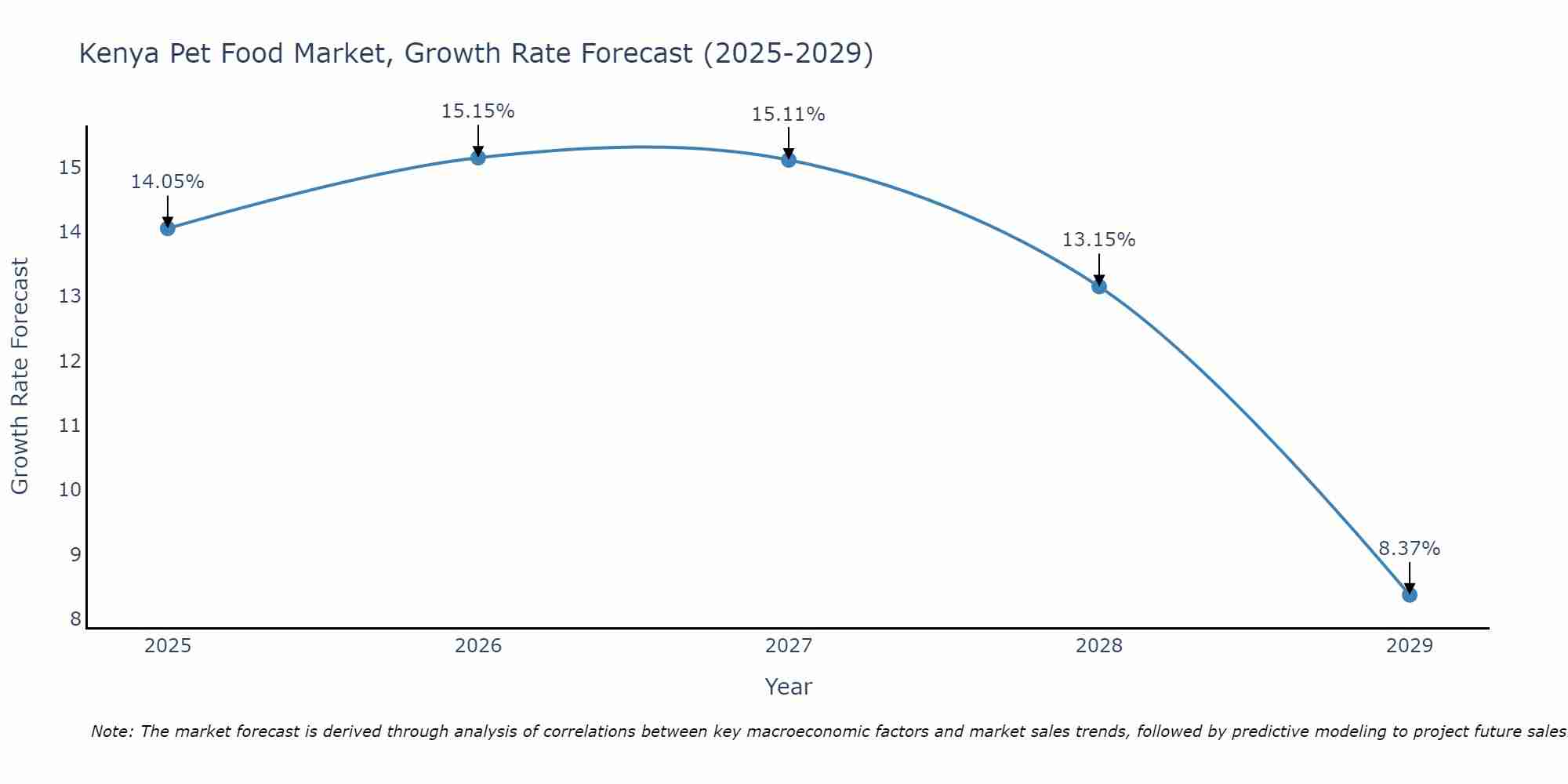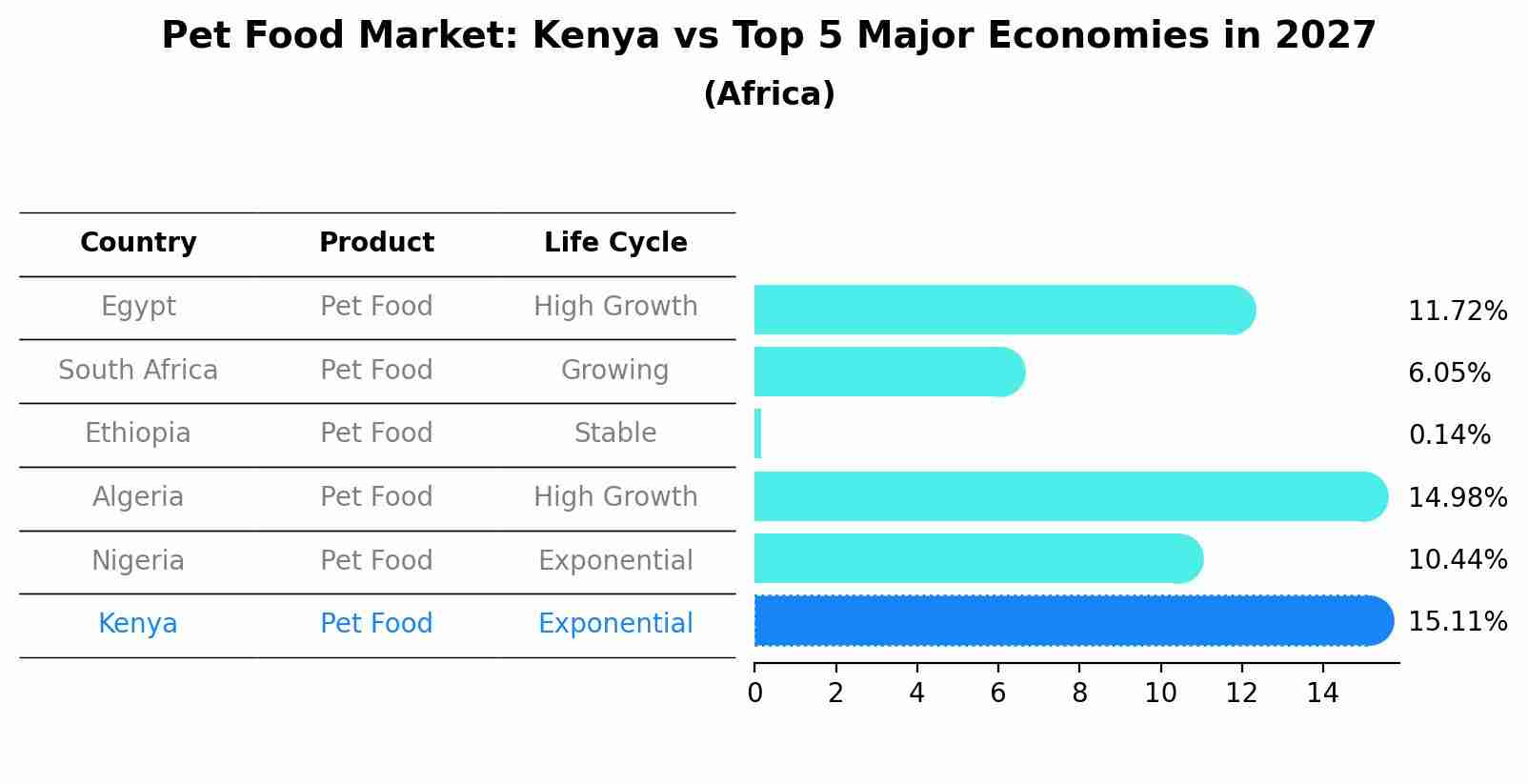Kenya Pet Food Market Outlook | Companies, Forecast, COVID-19 IMPACT, Growth, Size, Trends, Revenue, Share, Analysis, Industry & Value
| Product Code: ETC383930 | Publication Date: Aug 2022 | Updated Date: Jul 2025 | Product Type: Market Research Report | |
| Publisher: 6Wresearch | Author: Shubham Padhi | No. of Pages: 75 | No. of Figures: 35 | No. of Tables: 20 |
Kenya Pet Food Market Size Growth Rate
The Kenya Pet Food Market is projected to witness mixed growth rate patterns during 2025 to 2029. Growth accelerates to 15.15% in 2026, following an initial rate of 14.05%, before easing to 8.37% at the end of the period.

Pet Food Market: Kenya vs Top 5 Major Economies in 2027 (Africa)
The Pet Food market in Kenya is projected to grow at a exponential growth rate of 15.11% by 2027, within the Africa region led by Egypt, along with other countries like South Africa, Ethiopia, Algeria and Nigeria, collectively shaping a dynamic and evolving market environment driven by innovation and increasing adoption of emerging technologies.

Kenya Pet Food Market Synopsis
The Kenya Pet Food Market is experiencing steady growth driven by increasing pet ownership, urbanization, and a growing middle class with higher disposable income. The market is primarily dominated by dry pet food products, followed by wet and treats/snacks categories. Consumers are increasingly seeking premium and specialized products, leading to a rise in demand for natural, organic, and grain-free pet food options. Key players in the market include international brands like Royal Canin, Pedigree, and Whiskas, as well as local manufacturers and distributors catering to diverse consumer preferences. Distribution channels range from pet specialty stores to supermarkets, online retailers, and veterinary clinics. With a rising awareness of pet health and nutrition, the Kenya Pet Food Market is poised for further expansion and innovation in the coming years.
Kenya Pet Food Market Trends
The Kenya Pet Food Market is experiencing a shift towards premium and natural pet food products, driven by increasing pet ownership and a growing awareness of pet health and nutrition. Consumers are seeking high-quality, organic ingredients and specialized diets for their pets, leading to a rise in demand for premium pet food brands. Additionally, there is a preference for convenience and on-the-go packaging formats, such as single-serve pouches and resealable bags. E-commerce platforms are playing a significant role in the distribution of pet food products, offering a convenient way for consumers to access a wide variety of options and have them delivered directly to their doorstep. As pet owners continue to prioritize their pets` well-being, the market is expected to see further growth in premium and natural pet food offerings.
Kenya Pet Food Market Challenges
In the Kenya Pet Food Market, challenges include limited awareness and education about the benefits of commercial pet food among pet owners, leading to a preference for traditional homemade diets. Distribution and logistical challenges also hinder the availability of a wide variety of pet food products in remote areas. Additionally, the high cost of quality pet food relative to household income levels presents a barrier to widespread adoption. Lack of regulation and quality control in the pet food industry further contributes to concerns about the safety and nutritional adequacy of available products. Addressing these challenges will require targeted marketing efforts to educate consumers, improvements in distribution networks, and increased regulatory oversight to ensure the quality and safety of pet food products in the market.
Kenya Pet Food Market Investment Opportunities
In the Kenya Pet Food Market, there are various investment opportunities for potential investors. One key opportunity lies in the increasing pet ownership rates in the country, leading to a growing demand for high-quality and nutritious pet food products. Investing in the production and distribution of premium and specialized pet food to cater to this rising demand can be a profitable venture. Additionally, there is a shift towards more convenient and healthier pet food options, creating a space for innovative products such as organic, grain-free, and natural pet foods. Collaborating with local suppliers to source ingredients and manufacturing pet food locally can also be a strategic investment move. Overall, tapping into the expanding pet food market in Kenya presents promising opportunities for investors looking to enter this sector.
Jordan Agar Market Government Policies
The Kenyan government has established regulations under the Kenya Bureau of Standards (KEBS) to ensure the safety and quality of pet food products in the market. These regulations cover labeling requirements, ingredients, and production processes to safeguard the health of pets and consumers. Additionally, the government has imposed import restrictions and tariffs on pet food products to promote local manufacturing and support domestic producers. The government also encourages research and development in the pet food industry through incentives and support programs to enhance innovation and competitiveness. Overall, the government policies in the Kenya Pet Food Market aim to protect consumers, ensure product quality, and stimulate growth in the domestic pet food sector.
Kenya Pet Food Market Future Outlook
The Kenya Pet Food Market is expected to experience steady growth in the coming years as pet ownership continues to rise in the country. Increased urbanization, changing lifestyles, and growing disposable incomes are driving the demand for premium pet food products. Consumers are becoming more aware of the nutritional needs of their pets and are willing to invest in high-quality pet food options. Additionally, the trend of humanization of pets, where pets are treated as family members, is leading to higher spending on pet food products. The market is also witnessing a shift towards natural and organic pet food options as consumers become more health-conscious. Overall, the future outlook for the Kenya Pet Food Market appears promising, with opportunities for manufacturers to innovate and cater to the evolving preferences of pet owners.
Key Highlights of the Report:
- Kenya Pet Food Market Outlook
- Market Size of Kenya Pet Food Market, 2021
- Forecast of Kenya Pet Food Market, 2031
- Historical Data and Forecast of Kenya Pet Food Revenues & Volume for the Period 2018 - 2031
- Kenya Pet Food Market Trend Evolution
- Kenya Pet Food Market Drivers and Challenges
- Kenya Pet Food Price Trends
- Kenya Pet Food Porter's Five Forces
- Kenya Pet Food Industry Life Cycle
- Historical Data and Forecast of Kenya Pet Food Market Revenues & Volume By Type for the Period 2018 - 2031
- Historical Data and Forecast of Kenya Pet Food Market Revenues & Volume By Dry Food for the Period 2018 - 2031
- Historical Data and Forecast of Kenya Pet Food Market Revenues & Volume By Wet Food for the Period 2018 - 2031
- Historical Data and Forecast of Kenya Pet Food Market Revenues & Volume By Snacks/Treats for the Period 2018 - 2031
- Historical Data and Forecast of Kenya Pet Food Market Revenues & Volume By Animal for the Period 2018 - 2031
- Historical Data and Forecast of Kenya Pet Food Market Revenues & Volume By Dog for the Period 2018 - 2031
- Historical Data and Forecast of Kenya Pet Food Market Revenues & Volume By Cat for the Period 2018 - 2031
- Historical Data and Forecast of Kenya Pet Food Market Revenues & Volume By Others for the Period 2018 - 2031
- Kenya Pet Food Import Export Trade Statistics
- Market Opportunity Assessment By Type
- Market Opportunity Assessment By Animal
- Kenya Pet Food Top Companies Market Share
- Kenya Pet Food Competitive Benchmarking By Technical and Operational Parameters
- Kenya Pet Food Company Profiles
- Kenya Pet Food Key Strategic Recommendations
Frequently Asked Questions About the Market Study (FAQs):
- Single User License$ 1,995
- Department License$ 2,400
- Site License$ 3,120
- Global License$ 3,795
Search
Related Reports
- Portugal Electronic Document Management Market (2025-2031) | Strategy, Consumer Insights, Analysis, Investment Trends, Opportunities, Growth, Size, Share, Industry, Revenue, Segments, Value, Segmentation, Supply, Forecast, Restraints, Outlook, Competition, Drivers, Trends, Demand, Pricing Analysis, Competitive, Strategic Insights, Companies, Challenges
- France Electronic Document Management Market (2025-2031) | Strategy, Consumer Insights, Analysis, Investment Trends, Opportunities, Growth, Size, Share, Industry, Revenue, Segments, Value, Segmentation, Supply, Forecast, Restraints, Outlook, Competition, Drivers, Trends, Demand, Pricing Analysis, Competitive, Strategic Insights, Companies, Challenges
- Portugal Occupational Health & Safety Services Market (2025-2031) | Strategy, Consumer Insights, Analysis, Investment Trends, Opportunities, Growth, Size, Share, Industry, Revenue, Segments, Value, Segmentation, Supply, Forecast, Restraints, Outlook, Competition, Drivers, Trends, Demand, Pricing Analysis, Competitive, Strategic Insights, Companies, Challenges
- Netherlands Occupational Health and Safety Services Market (2025-2031) | Strategy, Consumer Insights, Analysis, Investment Trends, Opportunities, Growth, Size, Share, Industry, Revenue, Segments, Value, Segmentation, Supply, Forecast, Restraints, Outlook, Competition, Drivers, Trends, Demand, Pricing Analysis, Competitive, Strategic Insights, Companies, Challenges
- Belgium and Luxembourg Facility Management Market (2025-2031) | Strategy, Consumer Insights, Analysis, Investment Trends, Opportunities, Growth, Size, Share, Industry, Revenue, Segments, Value, Segmentation, Supply, Forecast, Restraints, Outlook, Competition, Drivers, Trends, Demand, Pricing Analysis, Competitive, Strategic Insights, Companies, Challenges
- Russia Women Intimate Apparel Market (2025-2031) | Strategy, Consumer Insights, Analysis, Investment Trends, Opportunities, Growth, Size, Share, Industry, Revenue, Segments, Value, Segmentation, Supply, Forecast, Restraints, Outlook, Competition, Drivers, Trends, Demand, Pricing Analysis, Competitive, Strategic Insights, Companies, Challenges
- Africa Chocolate Market (2025-2031) | Size, Share, Trends, Growth, Revenue, Analysis, Forecast, industry & Outlook
- Global Hydroxychloroquine And Chloroquine Market (2025-2031) | Industry, Trends, Size, Outlook, Growth, Value, Companies, Revenue, Analysis, Share, Forecast
- Saudi Arabia Plant Maintenance Market (2025-2031) | Industry, Size, Growth, Revenue, Value, Companies, Forecast, Analysis, Share & Trends
- Taiwan Electric Truck Market (2025-2031) | Outlook, Industry, Revenue, Size, Forecast, Growth, Analysis, Share, Companies, Value & Trends
Industry Events and Analyst Meet
Our Clients
Whitepaper
- Middle East & Africa Commercial Security Market Click here to view more.
- Middle East & Africa Fire Safety Systems & Equipment Market Click here to view more.
- GCC Drone Market Click here to view more.
- Middle East Lighting Fixture Market Click here to view more.
- GCC Physical & Perimeter Security Market Click here to view more.
6WResearch In News
- Doha a strategic location for EV manufacturing hub: IPA Qatar
- Demand for luxury TVs surging in the GCC, says Samsung
- Empowering Growth: The Thriving Journey of Bangladesh’s Cable Industry
- Demand for luxury TVs surging in the GCC, says Samsung
- Video call with a traditional healer? Once unthinkable, it’s now common in South Africa
- Intelligent Buildings To Smooth GCC’s Path To Net Zero













